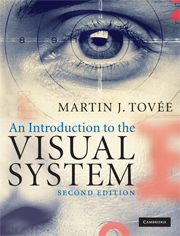Book contents
- Frontmatter
- Contents
- 1 Introduction
- 2 The eye and forming the image
- 3 Retinal colour vision
- 4 The organisation of the visual system
- 5 Primary visual cortex
- 6 Visual development: an activity-dependent process
- 7 Colour constancy
- 8 Object perception and recognition
- 9 Face recognition and interpretation
- 10 Motion perception
- 11 Brain and space
- 12 What is perception?
- References
- Index
- Plate sections
10 - Motion perception
Published online by Cambridge University Press: 05 June 2012
- Frontmatter
- Contents
- 1 Introduction
- 2 The eye and forming the image
- 3 Retinal colour vision
- 4 The organisation of the visual system
- 5 Primary visual cortex
- 6 Visual development: an activity-dependent process
- 7 Colour constancy
- 8 Object perception and recognition
- 9 Face recognition and interpretation
- 10 Motion perception
- 11 Brain and space
- 12 What is perception?
- References
- Index
- Plate sections
Summary
The illusion of continuity
In determining the nature of the movement of an object or scene across the retina, the visual system has to determine if the eyes are moving, the head or body is moving or the object itself is moving. To determine whether the eyes are moving, it seems that the cortical motor areas that control eye movement simultaneously send a signal to the visual system (the corollary discharge theory). For example, if the eye muscles of volunteers are temporarily paralysed, and they are asked to try and move their eyes, the volunteers report that the scene seems to jump to a new position, even though their eyes do not move and the scene does not change (Stevens et al., 1976; Matin et al., 1982).
It is important for the visual system to know about eye movements and to be able to compensate for their effects, as under normal circumstances our eyes are constantly moving. The reason for this constant movement can be found in the organisation of the retina. High acuity, colour vision is limited to the central 2 degrees of the visual field subserved by the fovea. Outside this small window, the spatial sampling of the retinal image declines sharply with increasing distance from the fovea (Perry & Cowey, 1985). Similarly, the packing of colour-sensitive cones declines by a factor of about 30 as one moves from central vision to 10 degrees of eccentricity (Curcio et al., 1991).
- Type
- Chapter
- Information
- An Introduction to the Visual System , pp. 147 - 163Publisher: Cambridge University PressPrint publication year: 2008



